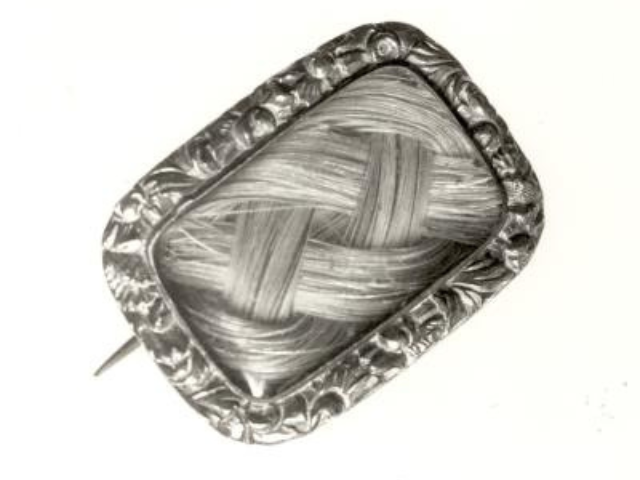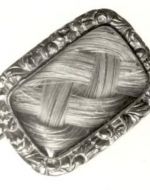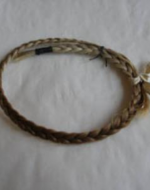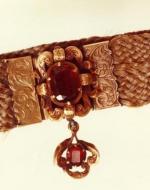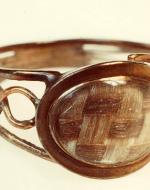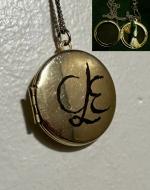Created by Augusta Williamson on Mon, 10/24/2022 - 19:00
Description:
Anne, Charlotte, and Emily are tied together through the books they published but also through the items they left behind. The Brontë’s subscription to mourning jewelry created a physical link between Charlotte and her siblings after their early deaths. Mourning jewelry is linked to the Medieval Cult of Saints, which used relics and reliquaries to be blessed by holy figures and to serve as a form of religious devotion. Victorian mourning jewelry served as a connection to loved ones who had died, to feel like the wearer was being blessed by the physical presence of their loved one. This is a very haunting concept but in Victorian times was less tied up in religion than the Medieval practices it stemmed from. Mourning jewelry was used in many places and treated in many ways before it hit its popularity in Victorian England. The most famous instance of Victorian mourning is Queen Victoria after the death of her husband, Prince Albert. She famously wore mourning clothes and kept mourning jewelry of her husband for the rest of her life. Queen Victoria also had mourning jewelry of her daughter Alice, who died in 1878. The prominence of death, the Victorian fascination with it, and the royal examples of mourning, enhanced the spread of Victorian mourning jewelry. This makes the presence of mourning jewelry in the Brontë’s lives and books unsurprising yet still haunting. This haunting quality of wearing a bracelet of hair seeps into the writings of the sisters. In Wuthering Heights, Heathcliff is haunted by Catherine, the only person he truly loved. Heathcliff was left with the writings that Catherine put in the margins of her books, but he left Catherine with a part of his physical self in having a lock of his hair buried with her. Jane Eyre treats mourning jewelry in a far more ritualistic way with St. John speaking of how he and his sisters would have mourning rings, a way to honor a member of their family rather than a way to tie themselves to the dead.
Hair Brooch, Brontë Parsonage Museum, date unknown. This is one of two hair brooches at the Brontë Parsonage Museum. It is 1.5 cm by 2 cm, made of hair, silver and glass. This was likely worn by one of the Brontës; however, the unknown date makes it hard to trace whose hair it is and who had it made. This brooch contains hair that has faded to white, common for hair jewelry that is not protected from light. It is possible that this is a mourning piece for Maria Branwell Brontë; however, that is speculation. Nearly all the hair jewelry at the Parsonage Museum has been identified as one the Brontë children, except for a few unidentified pieces, such as this one. This brooch is also in a different style to the pieces Charlotte wore in her life, suggesting that it was made at a different stylistic period and under the direction of someone other than whoever Charlotte commissioned for her pieces.
Lock of Anne's Hair, Brontë Parsonage Museum, before 1849. This is a lock of Anne’s hair, braided and secured by thread and ribbon. The center of the braid is still light brown; however, the ends have faded to white. Hair jewelry was not just made after death. It is highly likely that much of the hair used for the jewelry on display in the Parsonage Museum was collected before death, possibly before leaving for a new job or before going abroad, as Charlotte and Emily did. Anne's lock of hair may have been cut as a keepsake during her life, rather than just before her death. The Tenant of Wildfell Hall has a reference to hair jewelry though it is extremley brief. In Chapter XLV of the second volume, Gilbert vists Helen at Wildfell Hall and confronts her about the diary he just read. Helen nervously fidgets with her watch which is on a "hair-chain." Since Helen is of a higher class, it is unsuprising that she has some sort of mourning jewelry, possibly from her mother whom we never meet, or her father who passes away during the novel. Most likely other characters, such as Annabella or Walter Hargrave, would have also worn mourning jewelry due to their social status.
Bracelet of Anne and Emily's Hair, Brontë Parsonage Museum, date unknown. This bracelet is made up of Emily and Anne’s hair and has an amethyst in the center. It is assumed to have been worn by Charlotte after Emily and Anne’s deaths. This bracelet is not the only hair bracelet in the Parsonage Museum’s collection. There is an unidentified bracelet that has a similar style to Charlotte’s bracelet which is linked here. Mourning bracelets are not mentioned in Jane Eyre, Wuthering Heights, and The Tenant of Wildfell Hall, but Wuthering Heights does discuss intertwining hair. When Nelly Dean intertwines the hair of Catherine, Heathcliff, and Edgar Linton, there is an understanding that she is forever linking the three of them in a way that surpasses death. Charlotte wearing Emily and Anne’s woven hair around her wrist summons a similar idea, that the three sisters are inseparable in both the legacies they left and the remnants of their physical bodies.
Image sourced from Cove Cabinet, Locks, Lockets, and Literature by Hannah Taylor, 11.3.2020
Ring of Emily and Branwell's Hair, Brontë Parsonage Museum, date unknown. This ring is assumed to have been worn by Charlotte. The hair woven inside of the ring is Emily and Branwell’s, lightened with time. It is in the Brontë Parsonage Museum, along with many other pieces of mourning jewelry that Charlotte wore. Mourning rings were popular in Victorian England, especially after the death of Prince Albert. This ring is more elaborate than the rings mentioned in Jane Eyre. In Chapter XXX, St. John mentions that the inheritance left by their uncle was going to be just enough to cover the cost of three mourning rings. This is the only mention of mourning jewelry in Jane Eyre, which is logical as the fashion had not hit the height of popularity in the 1840s when the sisters published their novels. .
Image sourced from Cove Cabinet, Locks, Lockets, and Literature by Hannah Taylor, 11.3.2020
Recreation of a Victorian-Style Locket Inspired by Wuthering Heights, by Augusta Williamson, 2022. This is a locket that I painted to emulate what I imagined Catherine Earnshaw Linton’s locket would look like. On the outside, I painted Catherine's initials, CEL, in a traditional monogram style to match a possible design for the locket that appears in the novel. In Wuthering Heights, a pivotal moment in the death of Catherine comes when Nelly puts locks of hair from Heathcliff, Edgar Linton, and Catherine into a locket that Catherine might have worn post-mortem. Hair ties them together in death, just as they are tied together in life. In Chapter IX, Catherine refers to Heathcliff as "the eternal rocks beneath" and Linton as "the foliage in the woods" (Wuthering Heights, IX). Emily's characterization of Catherine's thoughts on her lovers pushed me to represent the threads inside the locket in different colors. Linton is the green thread as he is the foliage, and Heathcliff is golden as he is the ground on which Catherine stands. Catherine herself is represented in white, for she is not vibrant without Linton and Heathcliff to give her fire. By twisting together threads of these three colors, I symbolized the intertwining of their souls. The representation of mourning jewelry in Wuthering Heights is interesting partly because it is not a memorializing item for the living; it is given to the dead. This practice is reminiscent of various cultures' death rituals rather than the Medieval practices Victorian mourning jewelry stemmed from.

